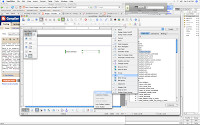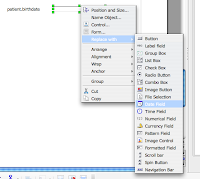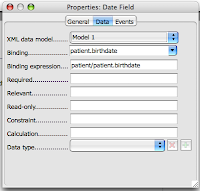(Note: After you've read this, see my
follow-up post.)
This past week I've been working with
InfoPath and
OpenOffice.org side-by-side to compare what InfoPath can do vs. what OpenOffice can do. I've started creating the Adult Initial Encounter form in OpenOffice, and so far I've been quite pleased with the results (as have the rest of the
OpenMRS gang). Here's a screenshot of part of the form:

I'm noticing that while InfoPath has a lot of drag-and-drop functionality, OpenOffice leaves much of it for the user to do. For example, in order to create a binding in InfoPath, you simply drag an element from the schema over to the document. You can then change what type of control it is (text field, radio button, date field, etc) and it will be nice and bound to your schema:

In OpenOffice, this isn't quite as easy. While you can drag an element from the data navigator directly to the document, you don't seem to have much control over what type of form control gets added. As you can see from the picture, it defaults to a simple text field with a label that I can't seem to change. While it allows you to replace the control with other controls, your choices are very limited. Hopefully this will be further developed in future versions:

In order to bind everything in OpenOffice, I've been selecting the binding from a drop-down list in the data tab of the control properties window. While this is perfectly doable, it's a bit tedious. I've posed a question to the
OpenOffice Users mailing list about this, so hopefully I'll have an answer soon.
If there's no better way to do this in the GUI, it's possible that I may be able to write a script that edits the XML files in the
.odt file that OpenOffice generates that fills in all of the bindings and default values. Both the InfoPath .xsn files and OpenOffice .odt files are zip files that contain XML and style sheets defining how the forms look and behave.
When the forms are submitted, they send an XML file to a remote server which then has some
XSLT which translates the data to
HL7. Here's an example of what this looks like, taken from the first screenshot, question 11a, "Is the patient or their partner currently using any form of family planning?":

If the user of the form checks the "Oral Contraceptive Pills" box, the
<oral_contraception/> element is set to
true, and
780^ORAL CONTRACEPTION^99DCT is the HL7 that is submitted.
I'm currently working on the rest of this form, and I'll start work on the others once it's finished. While the Adult Initial Visit form is rather large and tedious, I figure it's a good place to start because it will have a lot of reusable elements that I can copy and paste into other forms.
I'm pretty pleased with progress so far - I think things are going along quite nicely. Comments?















